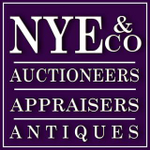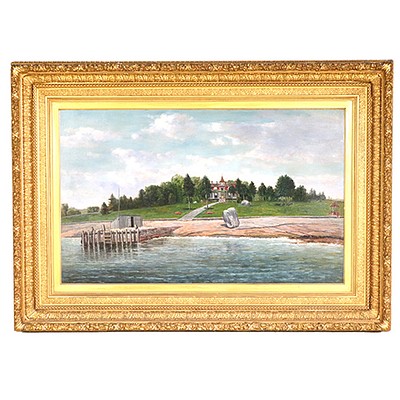Important Set of 12 Carved Walnut Side Chairs
Lot 245
About Seller
Nye & Co.
20 Beach Street
Bloomfield, NJ 07003
United States
At Nye & Company, what you like is all you need to know. Knowledgeable, helpful staff members, as well as nationally-known experts, work together to find the antiques and collectibles that will become your children’s heirlooms, all within your budget. John and Kathleen Nye acquired Dawson’s after hi...Read more
Estimate:
$3,000 - $5,000
Absentee vs Live bid
Two ways to bid:
- Leave a max absentee bid and the platform will bid on your behalf up to your maximum bid during the live auction.
- Bid live during the auction and your bids will be submitted real-time to the auctioneer.
Bid Increments
| Price | Bid Increment |
|---|---|
| $0 | $10 |
| $100 | $25 |
| $500 | $50 |
| $1,000 | $100 |
| $2,000 | $250 |
| $5,000 | $500 |
| $10,000 | $1,000 |
| $20,000 | $2,500 |
| $50,000 | $5,000 |
| $100,000 | $10,000 |
About Auction
By Nye & Co.
Apr 13, 2022
Set Reminder
2022-04-13 10:00:00
2022-04-13 10:00:00
America/New_York
Bidsquare
Bidsquare : April 13th, 2022 Estate Treasures Auction
https://www.bidsquare.com/auctions/nye/april-13th-2022-estate-treasures-auction-9093
Nye & Co. info@nyeandcompany.com
Nye & Co. info@nyeandcompany.com
- Lot Description
Possibly German, mid-18th C.
Note from Sotheby's: The profile and form of these chairs with their pierced splats and cabriole legs with claw-and-ball feet is clearly derived from contemporary English models, although its rococo-carved ornament is purely Continental in conception and execution. During the Hanoverian period there was obviously an interplay of design and craftsmanship between England and Germany as is shown by the close similarity between walnut bureau cabinets produced in London and Dresden in the 1730s (see Giseln Haase, Dresdener Möbel des 18. Jahrhunderts, Leipzig, 1986, figs. 72-84). A number of cabinetmakers in England are known to have had a thriving export trade with Europe. These included William Palmer (fl. 1730-1750) and John Phillips (fl. 1725-1762) whose trade cards were written in English, French and Dutch. In 1731 a fire at the premises of Giles Grendey (1693-1780) destroyed 'an easy chair of such rich and curious workmanship.... it being intended, `tis said, to be purchased by a person of Quality who designed it as a present to a German Prince' (see Beard and Gilbert, Dictionary of English Furniture Makers 1660-1840, Leeds, 1986, p. 371). Pattern books, such as Chippendale's Director (1753), which was issued in French, entitled Guide du Tapissier, de L'Ebeniste, similarly influenced Continental cabinet makers. A copy of this work was originally in the Kunstbibliothek, Berlin, but was destroyed in the Second World War.
Provenance: 'Magnificent English Furniture and Related Decorative Arts', Sotheby's, Lot 12, October 30th, 2002; Property From the Estate of Esmond Bradley MartinCondition reports are not provided in catalog descriptions. The absence of a condition report does not guarantee that the lot is in good condition or free from damage and wear. We encourage you to requisite a condition report and/or additional photos prior to bidding on any lot. We also recommended asking for a shipping quote before bidding as well. CASH, CASHIER CHECK, MONEY ORDER, AND WIRE TRANSFER ARE ONLY METHODS OF PAYMENT ACCEPTED FOR JEWELRY.Condition
- Shipping Info
-
Shipping info
-
- Payment & Auction Policies
-
Available payment options
-
-
- Buyer's Premium



 EUR
EUR CAD
CAD AUD
AUD GBP
GBP MXN
MXN HKD
HKD CNY
CNY MYR
MYR SEK
SEK SGD
SGD CHF
CHF THB
THB




































